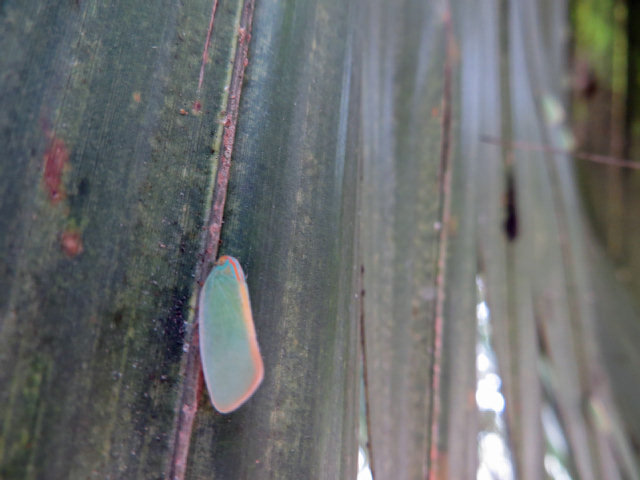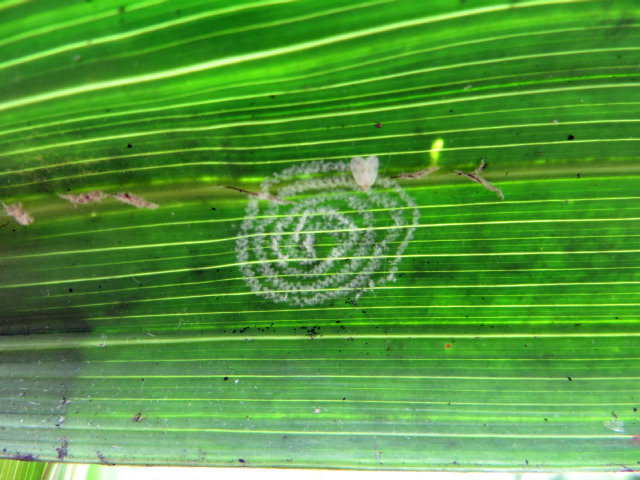Don’t Fret Much Over Pests Living Off Your Palm Trees

As published in the Miami Herald
After two consecutive chilly winters, a mild winter was essential this year to the health of our more cold-sensitive palms. But a warm winter coupled with our South Florida summers almost always leads to increased pest populations.
Just as palms suffer with a cold winter and flourish with a warmer one, so do insects. Our palm collections are rebounding after the mild winter, but so are the pests. This season is bound to be pest-infested. A few usual suspects definitely will be feasting on palms, but all of these critters can be handled.
Whitefly is today’s poster child of plant pests, attracting most of the limelight and stealing attention from other pests. Whitefly is a pest that completes its life cycle on the underside of palm leaves, but does not feed off of or take nutrients from the palm. The main issue with whitefly is that its excrement produces a thin film of black mold (often called sooty mold) that suppresses proper photosynthesis.
 |
| Plant hoppers in larval stage are commonly mistaken and easily confused for white fly. |
A similar pest that receives less attention is the plant hopper. Plant hoppers also live on the underside of palm leaves, take no nutrients from the palm but produce sooty mold that falls on the lower leaves. Both pests do not harm the plant in any way other than producing this black soot.
The appropriate solution to the sooty mold problem is not pesticide. A better, safer approach is to remove the pest and black soot with water. If the palm leaves are not very high up, wipe off the sooty mold and pests from the palm with a wet rag. If the palm is tall, find a high-pressure hose and spray the sooty mold off the leaves.
Spraying the whiteflies and plant hoppers also lets them know that they are not welcome. All living organisms are in search of a quiet, safe place to settle down and don’t like to be constantly disrupted. By spraying or wiping the palm leaf they live on every few days, you are sending them a strong message that this palm is not a peaceful place to live. After a few repetitions, these flying pests will leave in search of a better home.
 |
| Plant hoppers use palms for the same purpose as white fly – to complete their life cycle. |
Palm mites may also be on the rise in the next few months. With the summer heat and reinvigorated palms to feast upon, two mites can quickly become two thousand mites, and two thousand mites can be a problem.
The most common is the red palm mite, easily identified by its bright red body and small red spots on the surface of the leaf. Unless the palm was stressed before the infestation, possibly due to cold injury or nutrient deficiency, the mite should not harm the palm in any way other than aesthetics. If the palm is truly struggling because of the mite, then Neem oil is the best option. Due to the life cycle of the mite, complete elimination is difficult as the oil only kills adult mites. Application will need to be repeated every 10 days for a total of three applications. The repetition and time allotted between applications ensures that all adults are killed and unable to lay eggs.
 |
| Rugose Sprialing Whitefly is found on the underside of palm leaves. While their presence does not harm palms, the sooty mold they produce hinders photosynthesis. |
The last of the usual suspects is the royal palm bug. These little pests pick the newest palm leaf and live entirely off of that, leaving it brown, curly and frizzy. Usually, they only affect one leaf per plant per season. In a particularly bad season, they can damage two to three of the newest leaves. Since royal palms are relatively fast growers (they drop their leaves quickly and produce new ones), the royal palm bug’s mark is only temporary. There is a soil drench available but it is a proactive treatment used to deter a royal palm bug infestation before it happens. The pest does not have long-term effects and the treatment introduces a different set of chemicals into your backyard. For a non-commercial palm owner, treatment is unquestionably not worth the cost.
These usual suspects are not going to seriously injure palms and will most likely only persist for the summer. The colder winter months will bring their demise. The problems caused by these pests are most often aesthetic. After all, these pests rely on the health of the palm in order to live off of them. Serious damage to the palm is detrimental to the bugs. Therefore, the goal is to keep the summer pests and your palms in balance. In this way your palm is not hurt by the pests and can fully benefit from the warm weather and rain that it craves all year.
